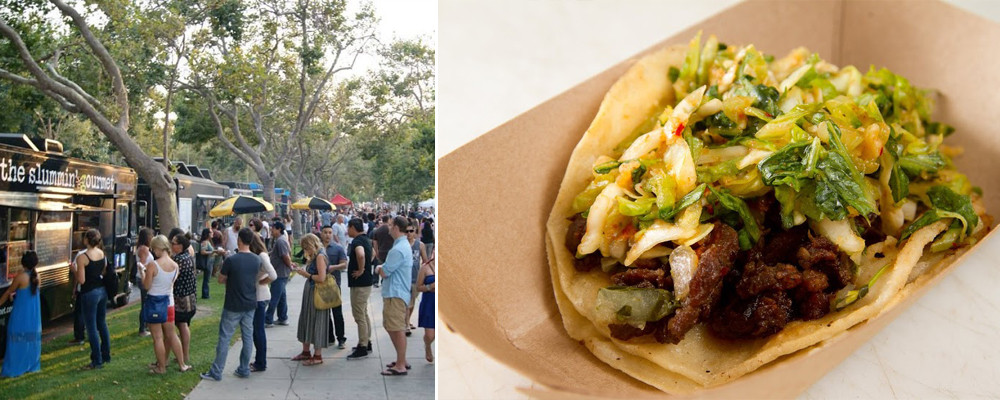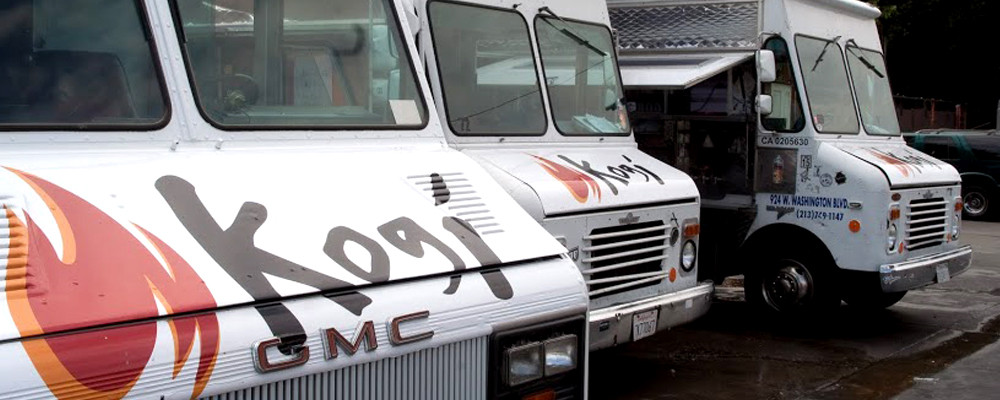The Evolution of Street Food in L.A.
Adam Novicki
Ask a foodie Angeleno about street food and you’ll find you get a handful of different reactions. Some rattle off the names and locations of over 200 “gourmet” food trucks that prowl LA. Others rave about the “street food” some famous French-trained chef serves at their Westside Barrio-Disney Taqueria. “The walls are decorated by authentic Mexicans. That’s legit!” The more adventurous share a secret about the location of a Saturday morning tamale lady in Pico Union who wakes the dead as she screams, “Champurrado! Tamales de Puerco! Dulce! Tamales!” Still others, while brutally hung-over and unable to cleanse their palate of whatever substance they ingested at an after party, they too share a vague recollection of stuffing something greasy in their mouths as they stumbled through Echo Park at 3am. This begs the question, what the hell is street food in LA? Is it the food truck or something else? How has it evolved?
Some mark the birth of the “street food” scene back to 2008, and the beginning of the Great Recession – or Diet Depression – or whatever the hell the “one percenters” call it, when Roy Choi (Kogi trucks, Chego, Sunny Spot, A-Frame, Pot), a laid off hotel chef, decided to mix his two favorite foods in one, and by doing so killed two birds with one taco. He created a new chapter in fusion cuisine, and more importantly, he was gainfully employed again. He survived.
The coyote instinct to survive runs in the blood of traditional street food vendors and their customers. Street food, recognized by the United Nations and the World Health Organization as a “powerful economic engine for rural people who have left their homelands to migrate to big cities,” represents the global #nofilter human condition. Anthony Bourdain’s Parts Unknown perfectly captures street food as a necessity for survival. “Fried roaches? No fucking way! – wait, I haven’t eaten for five days? – yes please, don’t hold back on the hemolymph.” And so it goes, each metropolis reflects the predominant ethnic group at the bottom rung. In Los Angeles, it’s our brothers and sisters from Central America. For these vendors, without papers, survival is paramount. The lady hawking champurrado on a chilly winter day (OK it was 59 degrees) strives to keep the lights on, feed her kids, and send money home to Mexico.
I’ve had inspired pork tamales in MacArthur Park at Mama’s Tamales – God gave them 5 stars on Yelp. I’ve also downed a bacon wrapped chorizo link outside the Halloween Superstore in Commerce. I personally saw the sausage climb out of the trunk of the ‘78 Monte Carlo and jump on the grill, but before that it glared at me and shouted, “Where you from?”
Did Kogi start the food truck movement? Roy Choi had his finger on the pulse when he decided to mix Korean with Mexican, but the trucks just represent a higher form of street food, a step up (literally) in the game of survival, towards American style prosperity, in the same way Ricardo Zarate’s savory Peruvian anticuchos (grilled street skewers of beef heart among others) symbolize survival too. In a Cool Hunting interview Zarate reveals,
“I opened (Mo-Chica) during the worst time in the economy. In 2009 it was hard to get anyone to invest even one dollar. For me, my vision was ‘this is my only opportunity.’ I had to jump into the storm and try to survive.”
Few remember that Raul Martinez Sr. started selling tacos out of a converted ice cream truck in 1974 and, six months later, opened a restaurant on Cypress Avenue called King Taco. Today, despite charging for an extra eye dropper of hot sauce, and shrinking their burritos to the size of bar of soap, their King Taco/El Taurino location remains a cross cultural smash, packed with Latinos, and Asians (mostly Korean) devouring al pastor, carnitas and carne asada, doused with their legendary smoky red and green tomatillo salsas.
Street food is now Main Street Food. Celebrity chefs chase the “street food” dream. Walter Manzke has Petty Cash, Timothy Hollingsworth, the former chef de cuisine at the French Laundry, dreams of opening a taqueria, and Spago just added a Cubano. And Jon Favreau’s Chef represents one cook’s quest for a reason to live by going back to the streets. So maybe the divide isn’t so wide. Food trucks cost upwards of $100k while a shopping cart with propane, baking sheets and aluminum foil costs nothing, you steal that shit! Street food opened the doors to hundreds of Culinary Institute graduates to make something of their degree. So show food trucks some love, but also throw a little love to the tamale lady selling champurrado at the bus stop. If there’s a line to buy the dodgy looking beverage, they can’t all be getting poisoned. Instincts of a coyote will save you!
STREET FOOD INSPIRATION:
Mo-Chica 514 West 7th Street, Los Angeles, 90014 | (213) 622-3744
Picca 9575 West Pico Blvd, Los Angeles, CA 90035 | (310) 277-0133
El Taurino (King Taco) 1104 South Hoover Street, Los Angeles, CA 90006 | (213) 738-9197
Petty Cash Taqueria 7360 Beverly Blvd, Los Angeles, CA 90036 | (323) 933-5300
FOOD TRUCKS:
(check websites for times and locations)
Mandoline Grill (Vietnamese)
White Rabbit Truck (Asian Fusion-Filipino)
The Beignet Truck (Authentic New Orleans Pastries)


